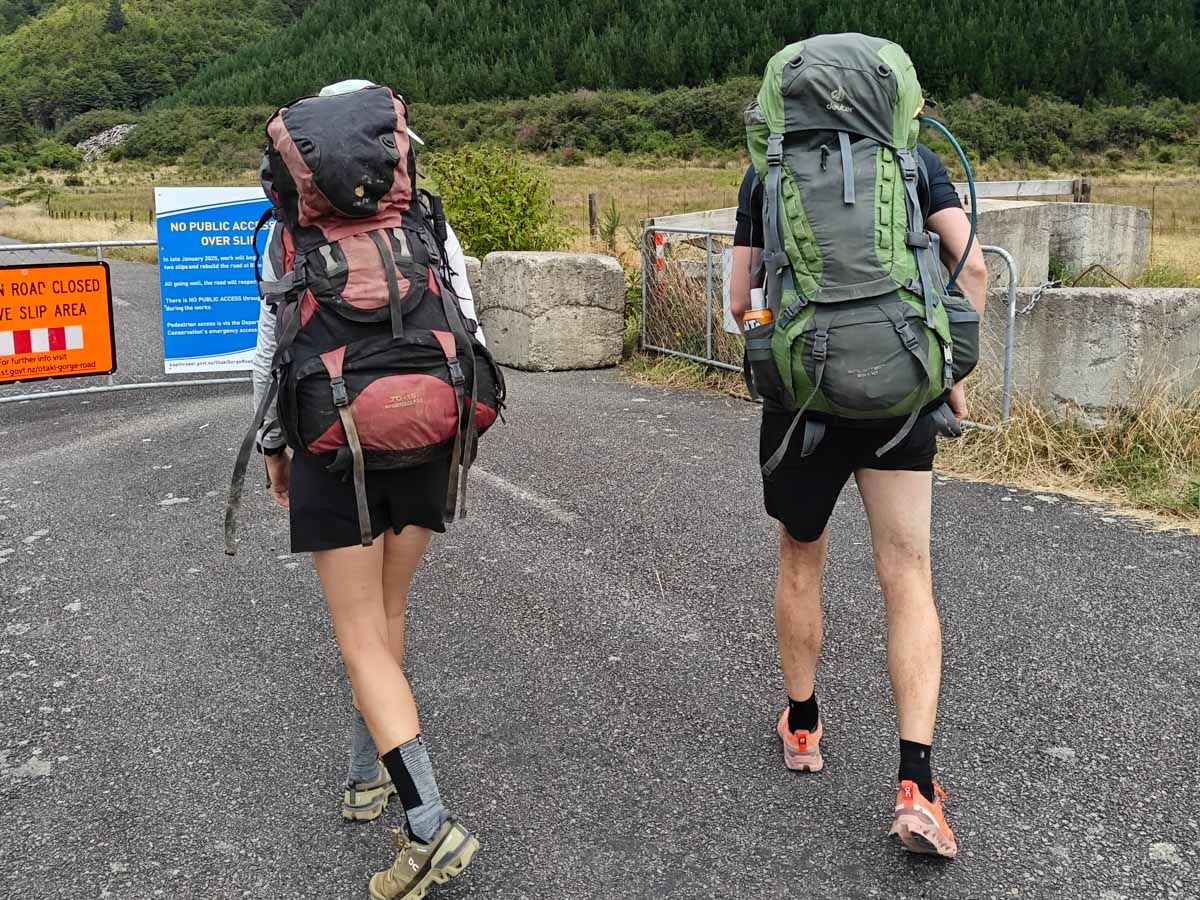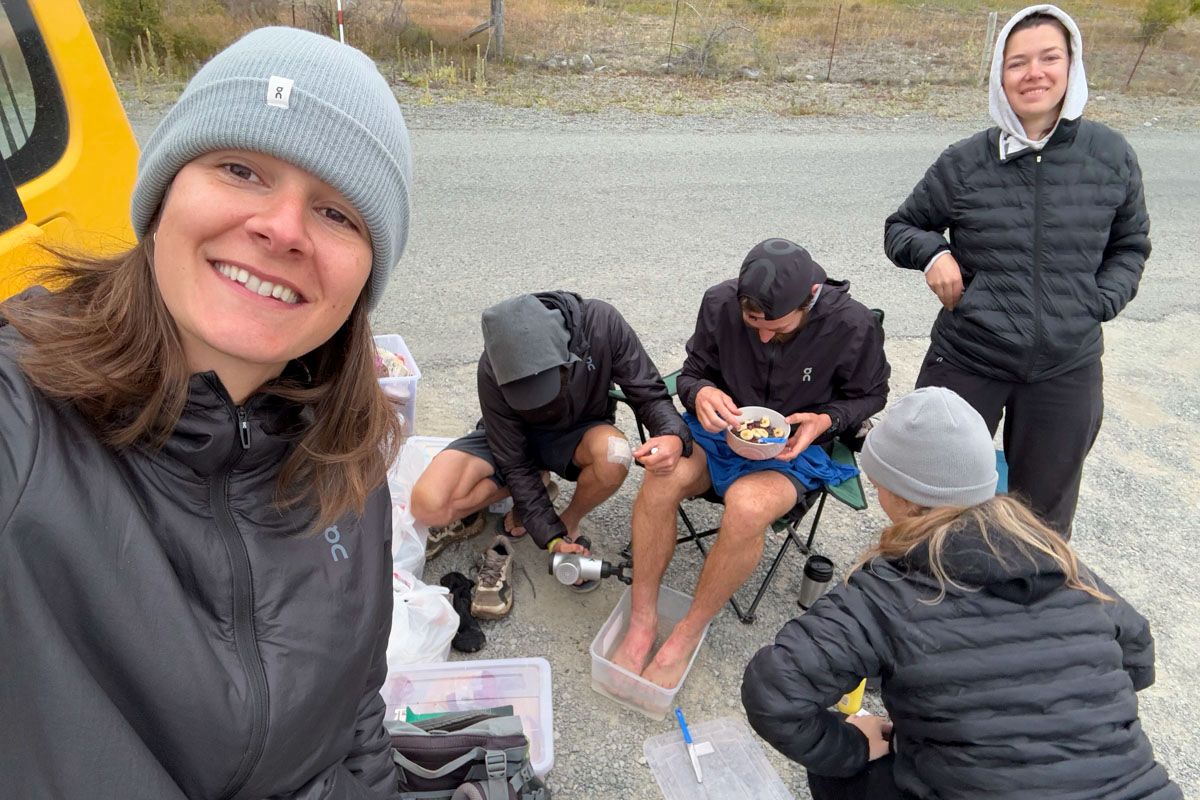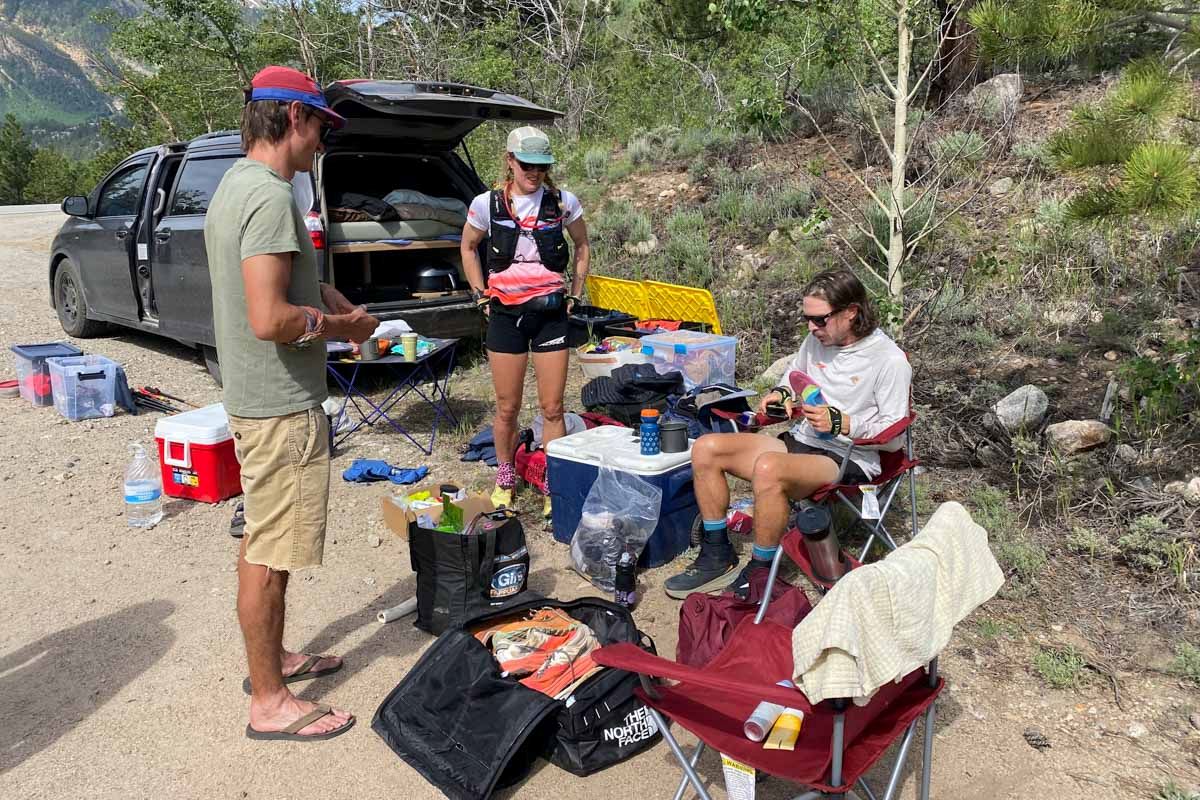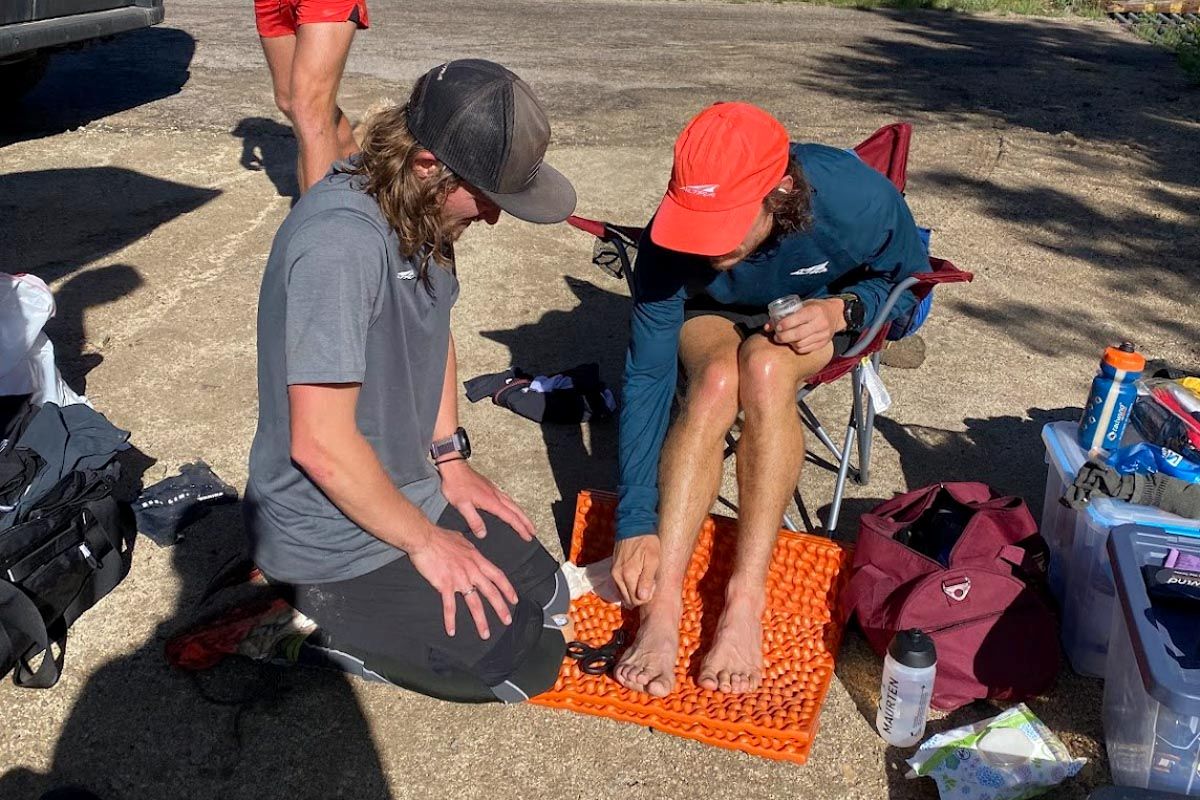The memes poking fun at runners asking friends and family to crew for them for ultramarathons are endless. While someone giving up a weekend to crew a runner is one thing, giving up weeks, or even months, to crew for a long-trail supported fastest known time (FKT) attempt is a whole different beast. But without these crews, who handle all of the logistics — from meeting up with a runner multiple times a day, preparing food, pacing, doing laundry, and countless other tasks large and small — it’s fair to assume the many FKTs would be significantly slower.
These crews, for the unimaginable amount of work that goes into supporting these efforts, are always gratefully thanked by their runner but rarely acknowledged by the wider world. Who are these people, and how do they function like a well-oiled F1 pit crew, as someone described Karel Sabbe’s team on his FKT on the Te Araroa (TA) in New Zealand earlier this year?
Tara Dower, who in 2024 broke Sabbe’s overall supported FKT on the 2,197-mile Appalachian Trail, says it well during an interview with iRunFar after her effort: “I would call it a team effort all around. Without [my crew], none of this would have been possible. I can see myself in a 100-mile race … I could probably survive off the aid station food and maybe just grit it to the end … But, for this type of long, supported record, it is only possible to do it with a crew, especially the overall record.”

Tara Dower (right) and her crew chief, Rascal, enjoying miles together on the Appalachian Trail. Photo courtesy of Tara Dower.
Those experienced with multi-day supported efforts understand the importance of well-functioning crews, but their efforts are mostly invisible to the outside world. There’s minimal glory in crewing, even if a runner does well and achieves their goals. Yet, when talking to the crews of three of the biggest FKT efforts in the past 12 months — Kyle Curtin on the 490-mile Colorado Trail (CT), Sabbe on the 1,898-mile TA, and Dower on the AT — one gets a sense of their unfaltering commitment to getting their runner from start to finish as quickly as possible as well as their willingness to put everything else in their lives on hold to help their person achieve their goals.
The Three Crews
The runners of these three FKT efforts as different as they come — Sabbe, a Belgian dentist, is best known for finishing the 2023 Barkley Marathons and setting FKTs on the AT in 2018 and the Pacific Crest Trail in 2023; Curtin is a Colorado-based runner who finished ninth at the 2021 Western States 100; and Dower, who recently moved to Colorado, and is known for her 2023 supported FKT on the Colorado Trail and finishing fourth in the 2024 Hardrock 100. Their crews were equally diverse in size, experience, and how they execute their roles.
Sabbe’s crew for the TA consisted of the same core crew that he used when he set his FKT on the PCT in 2023: his wife Emma Vandoorne, Emma’s cousins Marie and Anna Vandoorne, long-time friend and adventure partner Henri Deveene, and main pacer Kobe Blondeel. Deveene has the additional fun of looking similar to Karel, and says, “When the hair and the beards match, we sometimes look alike, and so I have this situation where people mistake me for him.”
Dower’s crew chief was Megan Wilmarth, perhaps better known by her trail name, Rascal. In an interview with iRunFar after Dower’s FKT, Rascal explains how they became friends while both hiking the AT in 2019, instantly clicking as two women wanting to do big miles. Rascal says of the end of the trip, “We summited [Mount] Katahdin together. It was a really special moment. We’ve been best friends ever since.”
Rascal would go on to crew Dower on her FKT on the 1,175-mile Mountains to Sea Trail in North Carolina in 2020 and fell naturally into the role, saying, “I just really enjoyed pushing her and pushing myself and figuring out the logistics on the fly.” She goes on to say, “We made a lot of memories and learned a lot about ourselves and each other, so it was worth it.”
Curtin put together a small crew mostly based out of his hometown of Durango, Colorado, including his partner, Sarah Ostaszewski, and Michael Robertson, a local runner with thru-hiking experience who’d also paced Dower on her FKT on the CT. Dower and Robyn Lesh, another highly experienced ultrarunner, split the third crew position. Ostaszewski, who had never crewed a long-trail FKT, says the group size was intentional, “[Curtin] did such a good job of having such a small, dialed crew. He knew who he wanted out there.” She goes on to explain the efficiency, “Each person has a task, as compared to too many people trying to do the same thing.”
Pre-Planning Efforts
One of the biggest logistical hurdles of FKT efforts is planning crew stops. Unlike organized races where crews only have the opportunity to see their runner at set aid stations — and often they’ll get driving directions to the aid stations from the event website as well as parking attendants telling them where to go — it’s up to a runner and their crew to determine the best intervals and locations to meet up, taking into consideration trail access, road quality, drive times, the need for support, and where the runner will sleep each night.
All three groups took different approaches to pre-planning. Ostaszewski says that Curtin put together a “giant spreadsheet” of all the potential crew spots and the logistics needed to get him from Denver to Durango. Curtin, Ostaszewski, and Robertson then had a single meeting before the attempt to go over the details. Both Curtin and Robertson were intimately familiar with the trail, while Ostaszewski, who knew far less of the trail, thru-hiking, and long-trail FKT attempts in general, says of the meeting, “They were all, ‘This makes sense. Sounds great.’ I’m like, ‘Wait a minute. I’ve got to go into depth here with these Google Maps and routes and make sure I know where I’m driving!”
For Sabbe on the TA, Deveene helped with the pre-planning of the logistics, something he was experienced with after taking on the same role during the PCT. Deveene says, “There’s a lot of time that goes into the preparation in terms of we talk about it for a long time, but in effort you put into it, it’s not too bad. We’ve all done this, so we all have the hang of it.” He continues, “It’s more for Karel and me just to have a look at the trail and what could be special, what could be areas that we need to take care of, how to reach him, and stuff like that. But it’s not too intense.”

The distinctive yellow van that was Karel Sabbe’s Te Araroa crew vehicle. Photo courtesy of Karel Sabbe.
Dower had Iceman [David Martin] on her crew to help with logistics on the AT. Rascal says, “[He’s] an FKT god. He’s been with Kristian Morgan [southbound supported AT FKT holder], he’s been with Karel Sabbe, he knows those roads [around the AT] like the inside of his eyelids.”
Flexibility and Planning on the Fly
Regardless of how much or how little the groups planned their logistics ahead of the FKT attempt, the idiom of “The best-laid plans of mice and men often go awry” holds true, and it was up to the crews to deal with constantly changing circumstances. Weather, trail conditions, tired runners, and endless other variables factored into how far the group could get each day. The crews hoped to function in a way that they could minimize the mental energy that their runner had to put into planning daily logistics. The runner’s job was simply to run.
Deveene says that while on the PCT, he could plan Sabbe’s schedule two to three days in advance, but the TA was far more unpredictable. “There were a lot of unexpected things that happened. Usually we make a plan for the next day, and then we follow the plan for the day, and then maybe some stuff happens and we go a bit further, or we do a bit less, and then during the day I’ll start making a plan for the next day.”

Henri Deveene (left) talking through planning with Karel Sabbe at a crew stop. Photo courtesy of Karel Sabbe.
Rascal didn’t start making mileage plans for Dower until they were out of the rugged and slow miles of Maine and New Hampshire. She says, “Mom [Debbie Komlo, Tara’s mother] and I did some math, and we were like, ‘We are far behind Karel’s record.’ … So it was like, ‘Okay, we need to bump up the mileage.’” Rascal calculated the number of miles Dower needed to do per day and added one or two to that number to figure out how far she had to push Dower each day. “Nickels and dimes,” she called the extra miles that ultimately added up.
Curtin’s effort, significantly shorter than the other two, seemed to play out as one continuous effort rather than one broken up into discrete days. While he’d stop and sleep for a couple of hours every 24-hour period, Ostaszewski says the daily planning on the fly consisted of small meetings where “the crew kind of made a little bit of a plan to get some more groceries before the next crew access point.” They had two cars, three people, and enough flexibility that one of them could run to get last-minute supplies while the others headed up to the crew spot.

Robyn Lesh and Sarah Ostaszewski await Kyle Curtin on a mid-trail crew-stop. Photo courtesy of Kyle Curtin.
Routines, Efficiency, and Inter-Crew Dynamics
If racing ultras is ultimately a game of minutes and seconds, long-trail efforts magnify the importance of saving even the smallest amounts of time whenever possible. Multiple minutes saved at crew stops add up to hours over the full duration. Take the stress of trying to function as efficiently as possible, add to it multiple sleep-deprived people existing in close quarters, and in Sabbe’s case, the need to function in a foreign country — even if it is New Zealand — one could imagine disagreements simmering and tempers flaring under the pressure.
While all the crews say that it took a few days to gel and get into their routines, it seems that their commitment to their runner — and quite possibly the personality type that would lead to someone being part of a long-trail crew — ultimately led to reasonably peaceful existence within the crews.
Sabbe’s crew seemed especially calm and centered. Deveene is quick to point out, “I think because you spend 30 or 40 days together in a car, and you don’t sleep very much, there’s definitely times where someone might be annoyed. I mean, you have it at home as well. It’s nothing to put on TV.” In fact, he says that their camera crew during the PCT effort seemed disappointed at the ease with which they all got along. “They want some kind of reality TV with lots of drama. You’re not going to get it with us.”

Karel Sabbe’s crew hauling in overnight gear for a section of the trail inaccessible by van. Despite the challenges, the team worked together peacefully throughout. Photo courtesy of Karel Sabbe.
Functioning as a well-practiced team, the crew simply got on with the job at hand. Deveene would wake up 20 minutes before Sabbe at 3:40 a.m. and prepare breakfast so that Sabbe could get up, put his shoes on, and start moving at 4 a.m. sharp, eating while walking. The 4 a.m. departure every morning made for one less decision each day, and Deveene would walk those early miles with Sabbe. He says of at time together, “We talk a bit about potential things that might be interesting throughout the day, sections that we need to be careful of, some sections that might not be as enjoyable, and by the time he finishes his breakfast, I need to walk back 20 minutes to go back to camp.” By then, the rest of the crew is up and ready to start the day.
Dower’s crew took a while to find their groove. Rascal says, “The first week, even into the second week … I wanted to quit every single day. I was crying my eyes out every day.” She continues, “There was this huge learning curve in the beginning. The sleep deprivation was the hardest thing to adapt to. It was so intense in weeks one and two that I could barely function.”
Curtin, with his relatively small crew and shorter effort, used fast crew stops to claw back valuable minutes and seconds from the jaws of inefficiency. At each crew stop, he’d pick up a new pacer, so his crew mostly focused on making sure that pacer was equipped with everything they needed to be ready to go as soon as Curtin arrived. The crew stops were fast: Someone would take care of Curtin’s feet, he’d eat something, and he’d leave. If Curtin needed to sleep, Robertson’s van — a minivan with burly tires specially outfitted for the effort with a fridge, freezer, and air fryer — was set up with a bed. The three-person crew made sure everything happened as quickly as possible. Ostaszewski says, “I think we kind of got into the rhythm pretty easily. I feel like there wasn’t a ton of discussion ahead of time about what each person does.”
Pacer Power
All three runners relied heavily on their pacers to carry their gear for them, allowing them to move as unencumbered and carrying as little weight as possible.
Sabbe’s team is quick to point out that the physical strength of their crew allowed them to be flexible with their planning and daily mileage. Marie Vandoorne says, “It’s a huge asset we have as a team — the physical power Henri has, and also Kobe.” For Sabbe, his main pacer, Kobe Blondeel was bitten by loose dogs while on the North Island, resulting in a trip to the hospital and a broken elbow, sidelining him from his main job of accompanying Sabbe for as many kilometers of the trail as possible. Needing to fill in, Deveene stepped up to the task. He says, “I did close to 900 kilometers of running and hiking combined, around 25 to 30 percent of the trail.” The others did big pushes as well, and Marie Vandoorne recounts, “We did a hike of 15 kilometers to reach [Sabbe] for delivery of lunch and a fresh backpack.”
Curtin lined up an all-star crew of pacers, including Courtney Dauwalter, Jeff Browning, and Maggie Guterl. Ostaszewski says that Curtin was able to reduce the amount his crew had to drive on rough roads by relying on strong pacers, saying, “He cut out some access points because he said his pacers could do more work and longer sections, and the crew can skip some of the very remote, rugged road spots.”
Watching Friends Suffer
Long-trail FKT attempts are often finished with a big final push where a runner forgoes sleep on the final night. For crews, this is a particularly intense time as there’s no room for error, their runner is on, or well past, the brink of exhaustion, and everyone is tired. It’s also a time when crews have to watch their runner dig really deep and suffer, and it’s never fun watching a friend or loved one in that condition.
Dower’s final push was just under 100 miles. Rascal explains that 59 miles into it, things started to unravel. She says of the crew stop with 41 miles to go, “I had done those last five miles [with Dower], and she was a mess. She was falling left and right. She was bawling her eyes out.” But Rascal had to put her emotions aside and tell her best friend that she was only allowed a 20-minute nap before she had to get up and go until the end.

Tara Dower, after setting an overall supported fastest known time on the Appalachian Trail. Photo: Pete Schreiner/@schreinertrailphotography
In the final 100 miles of the CT, Curtin started dealing with tendinitis issues in his ankle. He’d asked Ostaszewski and his friend Devon Olson to pace the final 18 miles of the trail outside of Durango. Ostaszewski says the hardest part of the whole experience for her was watching Curtin suffer those final miles. She says, “It’s dark, and it’s raining, and Kyle’s ankle was just really getting irritated. It seemed like he was in just so much pain trying to make it to the finish.” She goes on to say, “As a pacer, we’re giving him the water and the food and everything that he needs, but we can’t do anything about the ankle.” In pain, Curtin continued on and was greeted at the finish by his local run club. Ostaszewski says, “I was so happy for him to have such a big welcome back to Durango.”
Nearly everyone who saw or interacted with Sabbe on the TA described him as upbeat and happy, but when his crew livestreamed his final miles to Slope Point, it was obvious he was physically struggling. When asked how someone deals with seeing their friend in so much pain, Deveene says that Sabbe’s wife, who has been a consistent part of his crew during multiple FKT runs, has the best answer. He states she always says, “It’s his own choice. If he’s too tired or in too much pain, he can always stop.”
A Team Effort
It’s easy to understand the satisfaction of completing a long-trail FKT for a runner. It’s a concrete, personal achievement. But for the crew, how would one explain to a lay person that you’ve spent more than a month chasing a runner down a trail, meeting up with them three, four, six times a day to make sure that they’re fed, sheltered, and supported to the point that the only thing they have to worry about is putting one foot in front of the other?
The resounding theme in these three crews was being part of a team and working toward a greater goal together. When asked what drives him to support Sabbe, Deveene says, “There’s one goal, and that’s to make it as comfortable as possible for Karel to go from the start to the finish, and everything relates to that. Everything we do is because of that one mission. We’re all emotionally invested in it because he’s a friend.” Anna Vandoorne echos the sentiment, “It’s everybody coming together for the main goal and working together. It’s the best team I’ve ever been a part of.”
One can sense the pride crew members have in their runner and the satisfaction they feel in a job well done. Ostaszewski says, “I was just proud to see that it all came together. We were just happy to see him get it done.”

Sarah Ostaszewski (second from the left) with Kyle Curtin (center) and the rest of his crew after reaching Durango and setting a new overall supported FKT on the Colorado Trail. Photo courtesy of Maggie Guterl.
Call for Comments
- Have you experienced crewing for an FKT or long race?
- Have you ever had a crew that you felt particularly indebted to?




